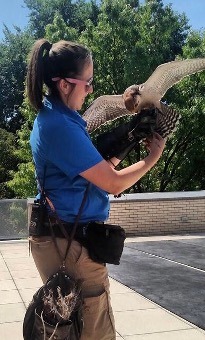by Raina Holt
I have always been super curious about how the natural environment influences people’s beliefs and rituals. As I learned about ancient Egyptian religion, I found elements that fascinated me. My curiosity led me to build a replica of a pyramid in 5th grade with a secret trapdoor inside. In college, I learned about mummification and continued to discover how and why the ancient Egyptians’ belief in an afterlife was so extensive. My recent internship with Carnegie Museum of Natural History gave me the opportunity to dig deep into my interest in Egypt using research to explore the significance of birds in ancient Egyptian religion.
Research involves asking questions and searching for answers by finding facts and information to explain the unknown. My research allowed me to explore how birds, including vultures, ibises, and even owls, were a big part of Egyptian culture and religion. In ancient Egypt, birds were very commonly associated with different gods. For example, the falcon represented the god Horus. In a comprehensive compilation of related essays titled, Between Heaven and Earth: Birds in Ancient Egypt (University of Chicago Press, 2012), the culture-wide association of gods with birds is partially explained as people’s perception that birds could fly and therefore be closer to the gods. Some birds of prey such as falcons, hawks, and owls are particularly skilled flyers, owing to physical adaptations such as long wings, relatively short tails, and powerful chest muscles. These features, when combined with others, including keen eyesight, sharp, curved talons, and sturdy, razor-edged bills, enable them to capture and kill prey. In some predator-prey encounters, speed is also a vital part of the killing equation. Lanner Falcons, for example, a species well-represented in ancient Egyptian art works, can reach diving speeds of up to 90 miles-per-hour in pursuit of smaller flying birds. Their strength, speed, and beauty made them ideal representatives for certain Egyptian gods.

In the Summer of 2017, I participated in a program called Soar! On Skydeck at the National Aviary on Pittsburgh’s North Side. I signed up, along with a handful of other Aviary visitors, because I knew I could learn at a deeper level through firsthand observation of live birds of prey. The highly skilled trainer, who worked with a Lanner Falcon during the presentation, relied upon a thick leather glove so her left hand could serve as a suitable and talon-proof resting perch for the bird.
The highlight of the presentation was a hunting demonstration. The trainer first let the falcon circle above us for a short while. Then the bird saw a chunk of meat placed for it and dove quickly, spreading its wings at the last moment to slow down and grab the food with its sharp talons. The falcon, as I could see with my own eyes, was fast, fierce, and powerful, which is why it was used to represent a god in ancient Egypt.
The god Horus, represented as a falcon or a human with a falcon head, was a sun god as well as the ancient Egyptian god of kingship, representing the living king of Egypt. Falcons, along with other birds, could have easily been seen by everyone in ancient Egypt. The sight of a falcon soaring overhead near the sun would have been a particularly striking scene. The pharaoh was believed to be not merely a powerful ruler, but to be the embodiment of the god, Horus. The job of Horus was to protect Egyptians in their daily lives, just like the pharaoh. In recognition of Horus’s important role, people would decorate their tombs with falcons. In later periods the ancient Egyptians offered mummified falcons to Horus, gifts which were sometimes placed in a small coffin with a bronze falcon on top.

Pittsburgh currently offers several falcon viewing opportunities. You can see Lanner Falcons, as I did at the National Aviary, but you can also watch the livestream of the Peregrine Falcon pair and their offspring in their nest on a high ledge of the Cathedral of Learning in Oakland! Because the feeding territory of these birds extends far beyond this University of Pittsburgh landmark, Peregrine Falcons can also be seen flying high above Schenley Park, and much of the University of Pittsburgh Campus. Occasionally the birds can even be heard screeching loudly near Carnegie Museum of Natural History and Carnegie Museum of Art!
Raina Holt is currently an intern for Carnegie Museum of Natural History’s Section of Anthropology. Museum staff, volunteers, and interns are encouraged to blog about their unique experiences and knowledge gained from working at the museum.
Related Content
Weighing She-Ra the American Kestrel
Carnegie Museum of Natural History Blog Citation Information
Blog author: Holt, RainaPublication date: June 21, 2021




